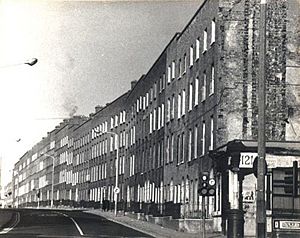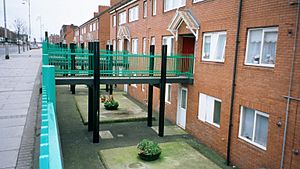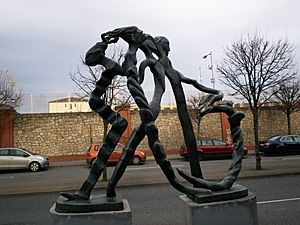Summerhill, Dublin facts for kids
Summerhill (Irish: Cnoc Críonáin) is a neighborhood in Dublin, Ireland. It is located on the north side of the city. The area is generally found between Gardiner Street to the west and Ballybough to the east. Its name comes from the main street, Summerhill Parade.
History of Summerhill
This area started to grow in the late 1700s. At that time, large, four-story brick houses were built along streets like Summerhill Parade and Gardiner Street.
Later, in the second half of the 1900s, many of these big old houses were replaced. New homes were built for families, changing the look of the streets. For example, Summerhill Parade saw many of its original houses taken down and new buildings put up.
In 1992, a special sculpture called Summerhill Group was revealed. It's made of bronze and sits on a stone base. The artist, Cathy Carman, created it to remember the street's past. It shows children playing, like they used to do on the street before it became a busy road.
John Hutton and Sons: Coach Builders
For almost 140 years, a very successful company called John Hutton and Sons was based in Summerhill. They were coachbuilders, which means they made fancy horse-drawn carriages. John Hutton started his business in 1779.
In 1788, the company got a big job: to build new mail coaches for Ireland. This helped them grow, and they moved to a larger workshop in Summerhill in 1789. Many people thought moving to Summerhill was a brave choice because it was a bit far from the main parts of Dublin.
However, the business did very well! In 1791, they even built the Lord Mayor of Dublin's coach, which was still used for special events many years later. They made coaches for important families in Ireland. The company also received special recognition from kings and queens, like a royal approval from George IV in 1821 and Queen Victoria in 1837.
One of their most famous creations was the Irish State Coach, ordered by Queen Victoria in 1852. This beautiful coach is still used today by the British monarch for important events, like traveling from Buckingham Palace to the Palace of Westminster to open Parliament.
As time changed, the company started making motor cars in the late 1800s. However, in the 1920s, they made a big mistake by not taking over the Ford business for the whole United Kingdom. This led to the company closing down in 1925. Their building in Summerhill was then sold and is now used by Dublin Bus.
Famous People from Summerhill
Many interesting people have lived in or are connected to the Summerhill area:
- Todd Andrews: An Irish political activist and public servant.
- John Keegan Casey: An Irish poet and speaker, known for writing the song "The Rising of the Moon".
- Bill Cullen: A well-known Irish businessman and TV personality.
- Thomas Farrell: An Irish sculptor.
- Kellie Harrington: An Irish boxer who won an Olympic gold medal. She grew up nearby.
- Peadar Kearney: An Irish republican and composer.
- Barry Keoghan: A famous Irish actor.
- Richard Edmund Meredith: An important Irish judge and public official.
- Cornelius O'Brien: An Irish politician and Member of Parliament.
- Clementina Robertson: An Irish artist who painted miniature portraits.
- Michael Ennis: A distinguished painter and decorator.




